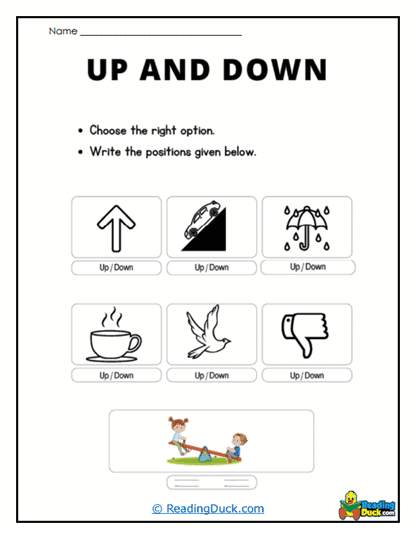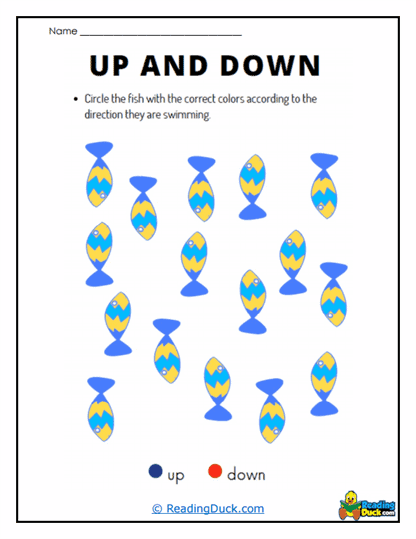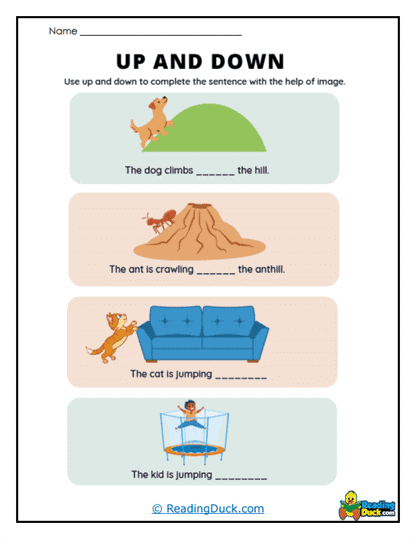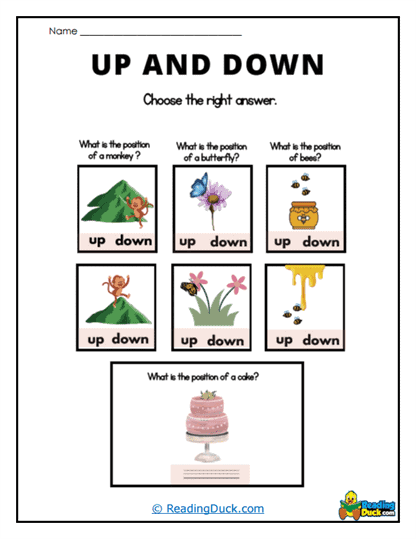Up or Down Worksheets
About Our Up or Down Worksheets
Our Up or Down worksheets are designed to help students master key spatial vocabulary, specifically the terms "up" and "down," which are foundational for understanding and describing spatial relationships. These worksheets fall under the Vocabulary category within the Skills section, particularly in the Position Words subcategory. Learning how to identify, describe, and use "up" and "down" accurately is an essential part of language development and spatial awareness, critical for both communication and cognitive development.
Available in easy-to-download PDF format, the worksheets are ready to be printed and used immediately in various educational settings. Each worksheet comes with a downloadable answer key, simplifying grading and allowing for quick assessment of student progress. Whether you’re a teacher, parent, or tutor, these worksheets provide a flexible, engaging resource for helping students strengthen their understanding of these position words.
Understanding the Concept of Up and Down
Position words like up and down help students describe spatial relationships, which is vital for interpreting their environment and communicating effectively. These terms describe movement and location in relation to a reference point, such as a person or an object. In early education, understanding how to use "up" and "down" correctly lays the foundation for more complex spatial reasoning and language skills.
In a classroom, a teacher might introduce these concepts with simple, everyday examples: "If I lift my hand into the air, it goes up. When I put my hand on the desk, it moves down." Using relatable, real-life scenarios helps students grasp these spatial relationships.
Examples of Using Up and Down in Sentences:
- "The ball rolled down the hill."
- "The bird flew up into the tree."
Our Up or Down worksheets reinforce these concepts through structured activities that encourage students to practice identifying and describing objects’ positions. Exercises might include circling objects that are up or down, labeling pictures, or connecting images that represent movement in either direction. Since these worksheets are provided in PDF format, they are easy to print and use in both classrooms and at home. The answer key that accompanies each worksheet makes it easy for educators to assess students’ comprehension quickly and efficiently.
Versatile Learning in Different Educational Settings
One of the strengths of our Up or Down worksheets is their versatility. These worksheets can be adapted for use in a variety of educational settings, from traditional classrooms to homeschooling environments and independent study programs. This flexibility makes them an excellent resource for reinforcing spatial vocabulary and concepts in multiple ways.
How the Worksheets Can Be Used Across Settings:
- Traditional Classrooms: Teachers can incorporate the worksheets into group activities, where students collaborate to identify which objects are positioned "up" or "down." This not only reinforces vocabulary but also encourages peer-to-peer learning, discussion, and teamwork.
- Homeschooling: Homeschooling parents can use the worksheets as part of a daily curriculum or as a supplemental activity. The structured format makes it easy to guide children through exercises that reinforce spatial concepts, and the answer keys provide instant feedback.
- Independent Study: These worksheets are perfect for independent practice, either during classroom quiet time or as homework. Students can work through the exercises at their own pace, solidifying their understanding of "up" and "down" without needing constant guidance.
- Enrichment and Remedial Work: Teachers can use the worksheets to challenge advanced learners with more complex spatial tasks or as a tool for remediation, offering additional practice to students who need support mastering spatial relationships.
The adaptability of these worksheets ensures that they can be tailored to suit a variety of learning environments and educational needs, whether in group settings or for individual learners.
Enhancing Early Language and Spatial Development
Mastering spatial words like "up" and "down" plays an important role in early language development. For young learners, these worksheets provide a structured and interactive way to practice essential vocabulary while also developing spatial awareness. These skills are fundamental to understanding how objects move and are positioned in the world, helping to support broader cognitive and linguistic growth.
Key Benefits for Early Learners:
- Building Vocabulary: The worksheets help children expand their vocabulary by teaching them how to use the words "up" and "down" correctly. Understanding these position words improves their ability to describe movements and locations in their everyday environment, enhancing communication.
- Strengthening Spatial Awareness: Recognizing and understanding spatial relationships helps children make sense of their physical surroundings. By practicing with "up" and "down," students develop stronger spatial reasoning, which is critical for future success in subjects like mathematics and science.
- Interactive and Engaging: The worksheets encourage hands-on interaction, using activities like matching, circling, and drawing to keep young learners engaged. These tasks help reinforce spatial concepts while making learning enjoyable and interactive, which aids in retention.
For early learners, developing a solid grasp of "up" and "down" not only improves communication skills but also lays the groundwork for more complex problem-solving and critical thinking abilities. The interactive nature of these worksheets keeps students engaged, making learning fun while reinforcing essential concepts.
Supporting English Language Learners (ELL)
Our Up or Down worksheets are especially valuable for English Language Learners (ELL), helping them master spatial vocabulary through clear visual examples and practical activities. Learning position words is essential for language acquisition, and these worksheets provide a straightforward, accessible way for ELL students to practice using "up" and "down" in context.
How These Worksheets Benefit ELL Students:
- Visual Cues: The worksheets include illustrations that clearly show the spatial relationships between objects. For ELL students, these visual aids help bridge the language gap, making it easier to understand the meaning of "up" and "down" without relying solely on written instructions.
- Simple Language: The instructions are written in clear, simple language, making the worksheets accessible to students at different levels of English proficiency. This ensures that even beginners can follow along and complete the activities with confidence.
- Hands-On Learning: By engaging in practical exercises, such as circling objects or drawing lines to match pictures, ELL students can apply the vocabulary in meaningful, real-life contexts. This reinforces their understanding of "up" and "down" and improves both their language proficiency and comprehension.
The combination of visual aids, simple instructions, and interactive tasks makes these worksheets an excellent resource for ELL students. They help students build confidence in using spatial vocabulary, supporting both their language acquisition and their ability to navigate everyday situations.
Teaching Strategies for Introducing Up and Down
To ensure students fully grasp the concepts of "up" and "down," educators can implement a variety of teaching strategies that encourage hands-on learning and active engagement. These strategies can be used alongside the worksheets to help reinforce understanding and promote mastery of spatial vocabulary.
Effective Teaching Strategies for Learning Up and Down:
- Use Physical Demonstrations: Teachers can use real-life objects to demonstrate "up" and "down." For instance, lifting a ball up in the air or placing it down on the floor helps students visualize and understand the spatial relationship.
- Incorporate Movement: Encourage students to physically move objects or themselves to demonstrate "up" and "down." For example, students can take turns placing items up on a high shelf or down on a desk, giving them a tactile way to understand the concept.
- Daily Practice: Integrate "up" and "down" into daily routines. For example, teachers can ask students to place their books up on a shelf or stand down in line for lunch. Frequent use of these words helps reinforce understanding through repetition.
- Storytelling with Visuals: Use images or short stories involving objects moving "up" or "down." Ask students to describe what they see, helping them practice using the vocabulary in context while developing their comprehension skills.
By using a combination of physical activities, verbal practice, and visual aids, educators can help students develop a deeper understanding of spatial relationships. These strategies, used alongside the worksheets, ensure that students have ample opportunities to engage with the vocabulary and build their confidence.
Conclusion
Our Up or Down worksheets provide a comprehensive, flexible resource for teaching students critical spatial vocabulary. Whether used in classrooms, homeschooling environments, or for independent study, these worksheets offer a structured and engaging way to help students master the concepts of "up" and "down."
By focusing on early language development, spatial awareness, and practical application, these worksheets ensure that students of all ages and abilities can strengthen their understanding of spatial relationships. They are particularly beneficial for English Language Learners (ELL), providing clear visual cues and simple language that make learning accessible.
Through a combination of hands-on activities, visual aids, and effective teaching strategies, educators can use these worksheets to help students gain confidence in their ability to describe spatial relationships. The Up or Down worksheets are a valuable tool for supporting both vocabulary development and spatial reasoning, helping students succeed in a variety of academic and everyday contexts.









